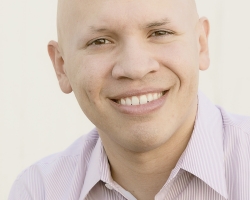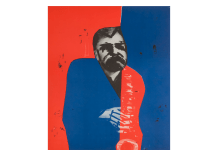Friday night was a cool night to be at Disney Hall. Who doesn’t like a two-piano piece and the world premiere of a “Battlefield” concerto? Even the lighting crew got into the act, providing intense, colorful accents to these pieces. The results were mixed but the experience was a fun one, especially with the resplendent Rachmaninoff that closed out the evening.
Sisters Katia and Marielle Labèque presented a unique take on Maurice Ravel’s “Rapsodie espagnole.” When hearing an amazingly orchestrated piece for a large group reduced to two pianos (incidentally, we don’t know which version he created first), one may well wonder how Ravel maintains the magic. The formula is in his exceptional piano arranging, though the Labèques’ controlled, carefully delivered sound was probably a less lavish outcome than anticipated.
Their tone is very round and immediate; the moment a flourish of color spilled out of the pianos, they coyly brought it back in. Treating it like a piano piece exclusively, they focused on its intricate design and mechanics. One might be confounded if expecting the pianos to imitate an orchestra with clever effects, but fascinated by how the Labèques gave blunt, unadorned explosions of force, along with unsentimental twinkling in the upper registers. It wasn’t for everybody, but it made an impression.
Next, the orchestra was divided down the middle of the stage for Richard Dubugnon’s new work, “Concerto for Two Pianos and Double Orchestra.” This Los Angeles Philharmonic commission of nine movements goes through all the pageantry and drama of a battle, including a parlay and post-war feasts. The Labèques were the principal antagonists, each with their own orchestral army. The concept proved more interesting than the content, however.
The orchestras were ably led by their general (the wonderful Russian conductor Semyon Bychkov), but the conflict was more esoteric than visceral. Overall, the work had a grave, bleak tone that wrangled with the philosophical horrors of war, occasionally punctuated by polyrhythmic verve from the orchestras and ardent playing by the sisters. The funeral march section was beautiful. It’s where the piece was at its most cohesive, thematically and emotionally. However, by the time the coda ended the work in triumph, it felt as if this conflict was related by a thoughtful historian rather than a war veteran who lived through the terror and anguish.
The second half of the evening was some of the best playing I’ve heard from the Phil this season, as they gave a shimmering account of Sergei Rachmaninoff’s “Symphonic Dances.” I could immediately tell how much Bychkov cares for this piece. He was meticulous with what he wanted (there must have been intense rehearsals), for the sound was precise and remarkably transparent. Each passage within the three movements sounded like the ideal version, particularly, the waltz in the second. It was impressionistic and pure, with great moments of clean power bursting through. I will remember this Rach long after I’ve left the concert hall.
Ebner Sobalvarro is a Los Angeles-based classical music and jazz aficionado. Having studied English at Boston College, he shares his passions for music at his blog cornerbooth.tumblr.com. Email him at ebner.sobalvarro@gmail.com.













